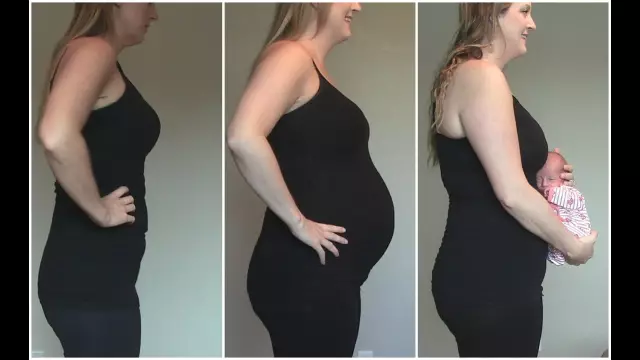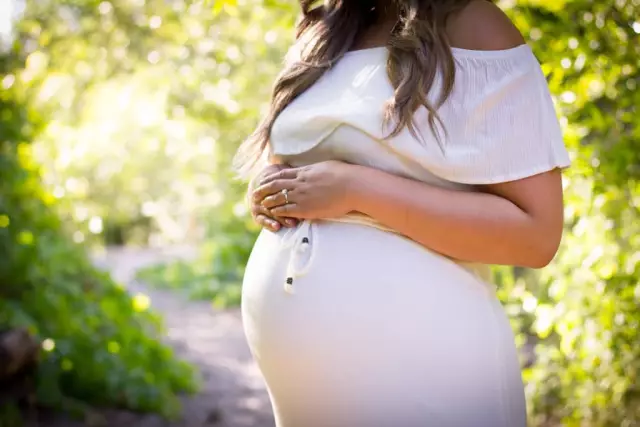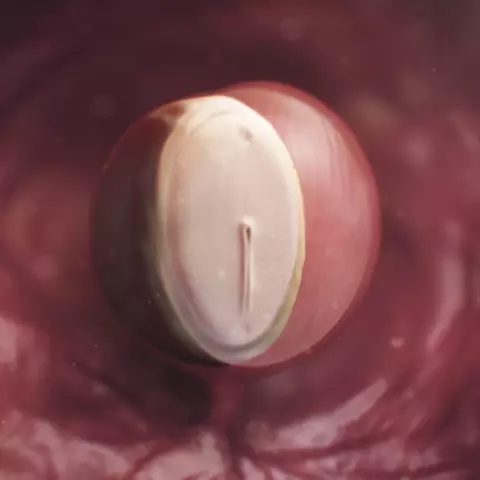- Author Rachel Wainwright [email protected].
- Public 2023-12-15 07:39.
- Last modified 2025-11-02 20:14.
40 weeks pregnant

At the 40th week of pregnancy, 38 weeks have passed from the moment of conception of the child, the tenth and last month of pregnancy is in progress.
Changes in the fetus
The fetus at 40 weeks of gestation weighs 3400 - 4000 g, its length reaches 54 - 55 cm. Its organs and systems are ripe for life outside the womb. The fetus at 40 weeks of gestation looks like a newborn, by its appearance you can determine the signs of its full-term:
- Sufficient weight and height;
- Good muscle tone and reflexes;
- The skin is pink, on the feet it has a transverse striation over the entire surface;
- The fingernails reached the edge of the phalanges;
- The auricles basically contain elastic cartilage and easily straighten if bent;
- The testicles in boys are lowered into the scrotum, in girls the labia majora completely cover the small ones;
- The umbilical ring is located in the center of the abdomen.
The nervous system of the fetus at 40 weeks of gestation continues to improve, new connections are formed between the cells of the cerebral cortex. The baby's adrenal glands are activated to release adrenaline and corticosteroid hormones. They help the fetus cope with the stress of childbirth and adjust to the environment after birth.
Changes in a woman's body at 40 weeks of gestation
If childbirth did not occur earlier, then it is likely that they will happen at the 40th week of pregnancy, from that moment you need to be ready for them completely.
The abdomen at 40 weeks of gestation most often drops, as the fetal head is pressed against the pelvic floor. The size of the abdomen at 40 weeks of gestation decreases and due to a decrease in the volume of amniotic fluid, now the bottom of the uterus is determined 34 - 35 cm above the womb. This week, a woman can feel the harbingers of childbirth - symptoms by which you can find out about their imminent approach.
There is a high probability that the mucous plug will come off if this has not happened before. This event is evidenced by the release of mucus from the vagina with a consistency that resembles egg white at 40 weeks of pregnancy.
Discharge at 40 weeks of gestation may normally increase, but abundant watery discharge is similar to amniotic fluid. If they have appeared, and there are no contractions yet, then a water test can be done in order to make sure that labor has not yet begun.
A greenish color and an unpleasant smell of discharge at 40 weeks of gestation is an unfavorable symptom, most likely, the fetus suffers in utero. Since the pregnancy is already full-term, the doctor, after assessing all risk factors, can decide on operative delivery or stimulation of labor.

Harbingers of childbirth also include recurrent cramp-like pains at 40 weeks of gestation that occur in the lower abdomen. A woman can also describe them as a feeling of a petrified abdomen, they are pulling in nature. If the contractions become regular, it means that labor is very close. The reason for the pain at 40 weeks of gestation is that the uterus contracts and, due to this, the cervix expands. Natural childbirth is possible only when the cervix is fully opened, that is, enough for the head of the fetus to pass through it.
If a woman gives birth for the first time, then childbirth can last at least 9 - 11 hours, if repeatedly - then 4 - 6 hours. The countdown begins from the moment of the appearance of regular contractions or the discharge of amniotic fluid - it is according to one of these scenarios that childbirth develops normally.
Even if the contractions did not begin at the 40th week of pregnancy, and the water was the first to leave, you should not be upset. As a result of the fact that the contents of the uterus have decreased in volume, the uterus is stimulated to the beginning of active contractions, that is, contractions. This feature is used to speed up labor, when the fetal bladder is pierced during labor.
Examination at 40 weeks of gestation
The condition of the fetus in the uterus, if necessary, is monitored using cardiotocography (CTG). The need for this may be in the case of a slowdown in its movements, leakage of colored amniotic fluid, or changes in the fetal heart rate.
A pregnant woman's exchange card with all the necessary research results should always be with the woman.
YouTube video related to the article:
Found a mistake in the text? Select it and press Ctrl + Enter.






